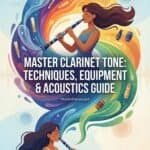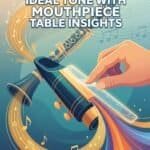The clarinet mouthpiece chamber is the hollow interior immediately behind the tip where air meets the reed. Chamber size (small, medium, large), depth (shallow, deep), width (narrow, wide) and shape (round, square, hybrid) all alter harmonic balance. Smaller, narrower, shallower chambers give a brighter, more projecting sound, while larger, wider, deeper chambers give a darker, warmer, more resonant sound.
What is the clarinet mouthpiece chamber?
The clarinet mouthpiece chamber is the hollow space inside the mouthpiece, directly behind the tip rail and facing, where vibrating air from the reed first expands. This interior volume and shape act as an acoustic filter that strongly influences tone color, response, intonation and projection before the air column continues into the barrel and clarinet bore.
On a typical B flat clarinet mouthpiece, the chamber begins where the facing curve ends and extends to the throat, which is the narrowest point leading into the back bore. Its geometry is defined by size, depth, width and shape, all of which interact with the reed, tip opening and facing length to create the playing feel that clarinetists notice immediately.
Technicians often describe chamber size in three broad categories: small, medium and large. Depth is described as shallow or deep, width as narrow or wide, and shape as round, square or hybrid. These terms are relative, but they give players a practical language to compare mouthpieces and to connect what they feel and hear with the underlying design.
From an anatomical perspective, the chamber sits between three critical regions: the facing and tip opening at the front, the throat and back bore at the rear, and the outer beak and body that define wall thickness. Small changes in any of these regions, especially near the throat, can change chamber behavior more than players might expect from the tiny visible differences.
How chamber dimensions (size, depth, width) shape tone and response
Chamber dimensions are the main levers that designers use to shape a mouthpiece's sound and feel. Size, depth and width all change how the air column resonates, which partials are emphasized, and how easily the reed starts and sustains vibration. Players experience these changes as differences in brightness, darkness, resistance and projection.
Chamber size: small, medium and large
Chamber size refers to the overall internal volume of the hollow space behind the tip. Small chambers have less volume, large chambers have more, and medium chambers sit between these extremes. Size changes affect the balance between fundamental and overtones, which listeners often describe as bright vs dark or focused vs broad.
Small chambers tend to raise the effective pitch of the mouthpiece-bore system and emphasize higher overtones. Players usually hear this as a brighter, more cutting sound with strong projection and quick response. This can help in jazz, big band and amplified settings where clarity and edge are important.
Large chambers lower the effective pitch and favor the fundamental and lower overtones. The result is a darker, rounder, more resonant sound that blends well in orchestral and wind ensemble contexts. Response can feel slightly slower, but many advanced players appreciate the extra tonal depth and flexibility in color.
Medium chambers aim for balance. They typically offer a mix of clarity and warmth, with moderate resistance and stable intonation. Many teachers recommend medium chambers for students because they are forgiving of embouchure inconsistencies and reed variation, while still allowing growth toward either a brighter or darker concept later.
Chamber depth: shallow vs deep
Chamber depth describes how far the hollow extends from the tip area toward the throat. A shallow chamber reaches its narrowest point quickly, while a deep chamber maintains a more open space for longer before tapering. Depth affects how the air column expands and contracts, which influences both articulation and legato response.
Shallow chambers often feel more immediate. The air column stabilizes quickly, which can make articulation crisp and high-register attacks very secure. Tonally, shallow designs tend to reinforce brightness and focus, especially when paired with a small or medium overall size.
Deep chambers give the air column more room to develop before it reaches the throat. Many players experience this as a slightly cushioned response with a smoother legato and a sense of “cushion” on the sound. Deep chambers usually support a darker, broader tone and can help tame shrillness in the upper clarion and altissimo registers.
Depth also interacts with intonation. Very shallow chambers, especially when combined with small overall volume, can make the upper clarion and altissimo tend sharp if the player uses a tight embouchure. Very deep chambers can sometimes flatten throat tones or make them feel unstable if the rest of the setup does not compensate.
Chamber width: narrow vs wide
Chamber width refers to how broad the interior is from side to side. Narrow chambers bring the side walls closer to the air column, while wide chambers allow more lateral expansion. Width changes the way sound waves reflect inside the mouthpiece and how the player perceives resistance and color.
Narrow chambers typically feel more resistant and focused. The sound can be very centered, with strong core and clear articulation. Many jazz and lead players like this quality because it helps the sound carry without spreading. However, some classical players may find extremely narrow chambers too constricted or edgy.
Wide chambers allow a more expansive air column. Players often describe the resulting sound as open, round and flexible in color. The perceived resistance may be lower, which can feel comfortable for players with a relaxed embouchure and strong air support. Wide chambers pair well with dark tonal concepts and large ensemble blend.
Width also influences how evenly the clarinet speaks across registers. Some narrow designs can make throat tones and low E and F feel tight or pinched, while some very wide designs can make the altissimo feel spread or unstable. Matching width to your air support and embouchure strength is critical for comfortable long-term playing.
Chamber shape types (round, square, hybrid) and their sonic signatures
Beyond size, depth and width, the contour of the chamber walls defines its shape. Designers often speak of round, square and hybrid chambers. These terms describe how the roof, floor and side walls curve or meet, and they correlate with distinct tonal and response characteristics that players can learn to recognize.
Round chambers
Round chambers have smoothly curved walls and roof, with no sharp internal corners. The cross section looks more like an oval or circle. Historically, many classical-oriented mouthpieces used rounded chambers to promote a singing, homogenous tone across the range of the clarinet.
Sonically, round chambers tend to produce a warm, blended sound with fewer pronounced high overtones. The tone can feel “covered” or “mellow” to the player, especially in the chalumeau and lower clarion. Response is usually smooth, with legato connections that feel natural and slurs that speak easily.
Round chambers can be very forgiving of small embouchure and voicing inconsistencies. For advancing students, this often translates to fewer sudden color changes between registers and a more consistent sound from low E to high C. Many orchestral players also favor this profile for its blend and flexibility.
Square chambers
Square chambers have flatter surfaces and more defined internal angles, especially where the roof meets the side walls. The cross section looks more rectangular or trapezoidal. These designs are often associated with brighter, more direct sounds and are common in setups aimed at jazz or commercial playing.
Acoustically, the sharper transitions in a square chamber encourage stronger reflections of certain overtones. Players usually hear this as more brilliance, edge and presence in the sound. The tone can cut through amplified bands and dense textures more easily, which is valuable in lead or solo roles.
Square chambers often have a very immediate response, especially in the clarion and altissimo. Articulation can feel crisp and percussive, making fast passages and accents stand out. However, some players may find the sound less forgiving or too bright for traditional classical repertoire, especially in small rooms.
Hybrid chambers
Hybrid chambers combine elements of round and square designs. For example, a mouthpiece might have a rounded roof with slightly flatter side walls, or a mostly round profile with subtle facets near the throat. These designs aim to balance warmth and clarity while fine-tuning response and intonation.
In practice, hybrid chambers can offer a centered core with enough brightness to project, without the extreme edge of some square designs. Many modern “all purpose” mouthpieces fall into this category, giving players flexibility to cover both classical and jazz with the same basic setup.
Hybrid shapes are also useful for addressing specific acoustic goals. A technician might slightly flatten part of a rounded chamber to stabilize certain notes or to add a bit of focus, while preserving the overall dark character. For most players, the important point is to listen for how the chamber shape affects clarity, warmth and evenness rather than focusing on the label alone.
How chamber interacts with airflow, facing length and tip opening
The chamber does not work in isolation. Its effect depends heavily on airflow, facing length and tip opening. These elements form a system: change one variable and the others feel different. Understanding this interaction helps players choose reeds and setups that let the chamber do its job effectively.
Chamber and airflow
Airflow is the engine that drives the reed and the air column. A chamber that feels responsive and resonant for a player with strong, steady air may feel resistant or dull for someone with weaker support. The same mouthpiece can seem “stuffy” to one player and “rich” to another simply because of differences in air speed and volume.
Small, shallow or narrow chambers usually require faster air to sound full rather than thin. Players with efficient diaphragmatic support often enjoy the clarity and projection these designs offer. Larger, deeper or wider chambers can feel more comfortable at moderate air speeds, but still reward strong support with more resonance and color.
Voicing, which is how the player shapes the oral cavity and tongue position, also interacts with the chamber. A very high tongue position combined with a small, bright chamber can exaggerate edge, while a lower, more open voicing with a large, round chamber can produce an especially dark tone. Adjusting voicing is often easier than changing mouthpieces and can help fine-tune the effect of a given chamber.
Chamber and facing length
Facing length is the distance from the tip of the mouthpiece to the point where the reed first meets the table. Longer facings allow the reed to vibrate over a larger area, while shorter facings concentrate vibration near the tip. Chamber behavior changes depending on how and where the reed flexes.
With a long facing, the reed motion is more gradual and flexible. A larger or deeper chamber can complement this by giving the air column more room to develop, resulting in a broad, singing sound. Many classical setups pair medium to large chambers with medium-long facings for this reason.
Shorter facings often feel more immediate and can favor crisp articulation. When combined with a small or medium chamber, they can yield a punchy, focused sound that responds quickly to tongue and air changes. This combination is common in jazz and commercial mouthpieces where clarity and attack are priorities.
If the chamber and facing length are mismatched, problems can arise. A very small chamber with a very long facing may feel overly resistant and unstable in pitch, while a very large chamber with a very short facing can feel too loose or spread. When troubleshooting, consider whether the facing and chamber are working together or against each other.
Chamber and tip opening
Tip opening is the gap between the tip of the reed and the tip of the mouthpiece when the reed is at rest. Small tip openings generally feel more resistant and favor softer reeds, while larger openings feel freer and often require slightly harder reeds. The chamber modifies how these tendencies are perceived.
A small tip opening with a small or shallow chamber can create a very focused, compact sound. Intonation can be stable, but the setup may feel unforgiving of embouchure tension and reed variation. Some orchestral players prefer this for its control, while others find it too rigid.
Larger tip openings with larger or deeper chambers can feel expansive and flexible. The sound can be very colorful, but the player must manage air support carefully to avoid spread or sagging pitch. Many jazz soloists favor this combination for its expressive potential and dynamic range.
Medium tip openings paired with medium chambers are often the most adaptable choice for students and doubler musicians. This combination provides enough resistance for control without feeling tight, and enough openness for color without losing core. When in doubt, start in the middle and adjust from there based on your tonal goals.
How to choose a chamber for your genre and player level
Choosing a clarinet mouthpiece chamber starts with your musical context and current level. Genre, ensemble type and personal tone concept all matter. Instead of chasing model names, focus on how chamber size, depth, width and shape align with the sound you need and the skills you already have.
Classical and orchestral playing
For classical solo, orchestra and wind ensemble, most players aim for a dark, round tone that blends well yet can project in large halls. Medium to large chambers with medium to deep depth and round or hybrid shapes usually support this goal. Width is often medium to slightly wide for openness without loss of focus.
Advancing students often do well with a medium chamber that leans slightly large, paired with a medium-long facing and medium tip opening. This combination offers stability for etudes and excerpts while still allowing growth toward a richer, more complex sound as air support improves.
Professional classical players may gravitate toward larger, deeper chambers with carefully tuned hybrid shapes. These designs can provide maximum color palette and dynamic range, at the cost of requiring more precise air and embouchure control. If you are still building consistency, avoid jumping straight to the most extreme dark setups.
Jazz, big band and commercial playing
Jazz, big band and commercial clarinet often call for a brighter, more projecting sound that can cut through rhythm sections, brass and amplification. Small to medium chambers with shallow to medium depth and square or hybrid shapes are common choices. Width tends to be narrow to medium for focus and edge.
Lead players in big bands frequently prefer small, shallow, relatively narrow chambers that provide quick response and strong upper partials. This helps the clarinet carry over the band without excessive effort. A slightly larger tip opening can add flexibility and allow expressive bends and inflections.
For players who switch between classical and jazz, a medium chamber with a hybrid shape is often the best compromise. It can be voiced darker for classical with reed and embouchure adjustments, yet still provide enough clarity and projection for jazz when paired with a slightly brighter reed or more forward voicing.
Student and advancing-intermediate setups
Beginners and advancing-intermediate players benefit from chambers that are forgiving and stable. Medium chambers with medium depth and width, and round or gentle hybrid shapes, usually provide the easiest path to a centered tone and reliable intonation while embouchure, air and finger technique develop.
Very small or very large chambers can magnify technical weaknesses. Small, shallow designs may encourage biting and thin tone if air support is weak, while very large, deep designs can feel stuffy and flat if the player does not yet manage voicing well. Teachers often report better progress when students start with moderate designs.
As students advance, they can experiment at the edges of medium. A slightly deeper or wider chamber can encourage a more mature, dark sound, while a slightly smaller or narrower chamber can help a naturally dark player gain clarity. The key is to change one variable at a time and listen carefully.
Doublers and multi-genre players
Players who double on saxophone or flute, or who cover multiple genres, need a chamber that adapts to different demands. Medium chambers with hybrid shapes are usually the most practical choice. They respond well to changes in reed strength, voicing and articulation style without forcing a complete equipment change.
Some doublers keep two mouthpieces: one with a slightly larger, rounder chamber for classical work and one with a slightly smaller, squarer chamber for jazz and commercial work. If you choose this route, keep facing length and tip opening similar between the two so embouchure adjustments remain manageable.
Practical workshop: listening tests and measurement procedures
Systematic testing helps you connect chamber dimensions with what you hear and feel. A simple workshop approach uses controlled listening tests and basic measurements. You do not need specialized equipment to start, just a few mouthpieces, a tuner, a recording device and a consistent reed setup.
Step 1: Standardize your test conditions
Begin by choosing one reed strength and brand that works well for you. Prepare at least two reeds of the same model that play reliably. Use the same ligature, clarinet, barrel and room for all tests. This minimizes variables so chamber differences stand out more clearly in your recordings and impressions.
Warm up on your usual mouthpiece for 5 to 10 minutes, then mark a short test routine: a slow scale from low E to high C, a few slurred intervals across the break, a chromatic scale, and a short lyrical phrase. Use this same routine for every mouthpiece so you can compare response and tone directly.
Step 2: Listening tests with recording
Record yourself playing the test routine on each mouthpiece, starting with the one you know best. Announce the mouthpiece before each take. Try to keep dynamics, articulation and tempo as consistent as possible. Do not judge while you play; focus on consistency and comfort.
Later, listen back without looking at which mouthpiece is which. Take notes on brightness vs darkness, focus vs spread, ease of articulation, evenness across registers and intonation tendencies. If possible, ask a trusted colleague or teacher to listen blindly and write their own impressions.
After forming your impressions, compare them with the known chamber characteristics of each mouthpiece. Look for patterns: do you consistently prefer medium or larger chambers, or do you gravitate toward narrower or wider designs? Use these patterns to guide future choices rather than relying on marketing descriptions alone.
Step 3: Basic measurement procedures
While exact chamber volume requires specialized tools, you can gather useful comparative data with simple measurements. Use a digital caliper to measure the external width and height of the mouthpiece body at the chamber area, and note the throat diameter if visible. These numbers help you correlate physical size with your listening impressions.
For a rough sense of relative chamber size, you can perform a water displacement test on retired or inexpensive mouthpieces. Seal the tip and table with waterproof tape, fill the chamber through the shank with a syringe, and measure the volume of water used. Do not attempt this on valuable mouthpieces without guidance, as water can damage cork and pads if it leaks.
Photograph the interior of each mouthpiece using a small light and a smartphone camera. Comparing these images side by side reveals differences in depth, width and shape that are hard to see by eye alone. Label each photo with your listening notes to build your personal reference library.
HowTo schema note
These workshop steps function like a simple how-to guide: standardize conditions, record and listen, then measure and document. Repeating this process over time with more mouthpieces will sharpen your ability to predict how chamber descriptions on a spec sheet will feel and sound in your hands.
Materials, maintenance and when chamber issues mimic other problems
Although chamber geometry dominates acoustic behavior, mouthpiece material and condition also matter. Hard rubber, crystal, metal and modern synthetics all transmit vibration differently. More importantly, chips, warping or residue inside the chamber can mimic chamber design problems, so regular inspection and cleaning are important.
Material and resonance
Most clarinetists use hard rubber or plastic mouthpieces. Hard rubber tends to dampen some high-frequency noise, contributing to a smooth, refined sound. Plastic can feel slightly brighter or more brittle, though design differences often overshadow material. Crystal and glass can offer very clear, immediate response but are more fragile.
Within a given design, material differences are usually subtle compared with chamber, facing and tip opening. When evaluating a mouthpiece, prioritize how the chamber and facing work for you before worrying about material. Once you find a geometry that suits your playing, then consider whether a different material version of that design offers any advantage.
Maintenance steps for the chamber
Regular maintenance keeps the chamber performing as designed. Food particles, mineral deposits and reed fibers can accumulate on the chamber walls and throat, slightly altering the effective shape and surface texture. Over time, this can dull response and reduce resonance, especially in the upper register.
Follow these basic steps:
- After each playing session, swab the mouthpiece gently with a soft, lint free pull-through designed for mouthpieces.
- Once a week, rinse the mouthpiece in lukewarm water and use a soft brush to clean the chamber and throat. Avoid hot water, which can warp plastic or hard rubber.
- For stubborn deposits, use a mild dish soap solution and a soft brush. Rinse thoroughly and dry completely before storing.
- Inspect the chamber visually under good light for chips, cracks or rough spots that could affect airflow.
Never use abrasive tools or harsh chemicals on the chamber. Scratches or gouges can permanently alter how the air column behaves. If you suspect internal damage, consult a qualified technician rather than attempting repairs yourself.
When chamber issues mimic other problems
Many playing problems that seem like chamber issues actually come from reeds, embouchure, ligature placement or the clarinet itself. Before blaming the chamber, rule out these more common causes with simple checks and comparisons.
If you experience poor response, try several fresh reeds of the same strength, then one slightly harder and one slightly softer. If the problem changes dramatically with reeds, the chamber is probably not the primary culprit. Check that the ligature is centered over the heart of the reed and not overly tight.
For intonation problems, test with a tuner on long tones across the range using your usual mouthpiece and at least one other mouthpiece with a known, reliable chamber. If both show similar tendencies, the issue may lie in your voicing, barrel length or clarinet bore rather than the chamber.
When in doubt, ask a teacher or technician to play your setup. If they can produce a stable, resonant sound, the chamber is likely fine and you may need to adjust technique. If multiple experienced players struggle with the same mouthpiece, then chamber design or condition becomes a more likely factor.
Troubleshooting common mouthpiece chamber problems and outcomes
When chamber design or condition truly is the issue, the symptoms often follow recognizable patterns. Learning these patterns helps you decide whether to change mouthpieces, adjust other setup elements or consult a technician for evaluation and possible rework.
Symptom: Thin, edgy tone and sharp high register
If your sound feels thin and edgy, especially in the clarion and altissimo, and the upper register tends to run sharp, you may be playing a chamber that is too small, shallow or narrow for your current air and embouchure. This is common when a player with a naturally high voicing uses a very bright design.
Try these steps:
- Experiment with a slightly larger or deeper chamber, or a rounder shape, while keeping reed and tip opening similar.
- Lower your voicing slightly by imagining saying “oh” instead of “ee” while playing.
- Check that you are not biting; relax the jaw and support with air instead.
If a medium or larger chamber immediately improves warmth and pitch stability, your previous chamber was likely too small for your tonal goals.
Symptom: Stuffy response and flat pitch
A stuffy, unresponsive feel with flat pitch, especially in the throat tones and upper clarion, can indicate a chamber that is too large, deep or wide for your current setup. This is often reported by students who switch too quickly to very dark mouthpieces without the air support to drive them.
Try these steps:
- Test a mouthpiece with a slightly smaller or shallower chamber, or a more focused hybrid shape.
- Increase air speed by supporting from the diaphragm and maintaining a steady, fast airstream.
- Check for internal dirt or damage that might be constricting the throat or chamber.
If a smaller or more moderate chamber restores clarity and pitch, your original mouthpiece may simply be too large for your current technique or ensemble needs.
Symptom: Uneven tone or response between registers
Unevenness between chalumeau, throat tones and clarion can come from several causes, but chamber design is one of them. A chamber that is too narrow or shallow can make throat tones pinched and resistant, while an overly wide or deep design can make the altissimo feel spread or unstable.
To diagnose, compare your mouthpiece with another that has a clearly different chamber category. If the pattern of unevenness changes significantly, chamber geometry is likely involved. If the pattern remains similar, look instead at reed cut, facing length or clarinet bore alignment.
Technicians can sometimes smooth out small chamber irregularities that cause specific notes to misbehave. However, large design mismatches usually call for a different mouthpiece rather than extensive reworking. It is often more economical and reliable to choose a design closer to your needs from the start.
Symptom: Lack of projection in ensemble
If your tone sounds good up close but disappears in ensemble playing, the chamber may be too large, too round or too wide for the context, especially in jazz or band settings that require more presence. Alternatively, your voicing and articulation may not be taking advantage of the chamber's potential.
Ask a colleague to listen from the back of the room while you test a medium or slightly smaller chamber with a hybrid or square shape. If projection improves without sacrificing too much warmth, consider moving toward that design. Also experiment with slightly firmer articulation and a more forward voicing to bring out higher overtones.
When to consult a technician and why not to reshape yourself
Chamber reworking is a specialized procedure. Removing or adding material inside the chamber changes not only size and shape but also how the reed, facing and bore interact. Small mistakes can ruin a mouthpiece or create unpredictable intonation issues that are hard to correct.
Consult a qualified mouthpiece technician if:
- You suspect internal cracks, chips or warping.
- You have a mouthpiece you love except for one or two specific notes or a narrow response issue.
- You want a professional opinion on whether a minor chamber adjustment could help.
Avoid DIY reshaping with files, sandpaper or rotary tools. Even experienced players who understand chamber theory can misjudge how much material to remove or where to remove it. Once material is gone, it cannot be replaced without complex work. For most clarinetists, selecting a better matched design is safer and more effective than attempting internal modifications.
Key Takeaways
- The clarinet mouthpiece chamber is the hollow behind the tip that shapes tone, response and intonation through its size, depth, width and internal shape.
- Smaller, shallower, narrower chambers with square or hybrid shapes tend to sound brighter and more projecting, while larger, deeper, wider, rounder chambers favor darker, warmer, more resonant tones.
- Chamber behavior depends on airflow, facing length, tip opening and voicing, so evaluate mouthpieces through controlled listening tests and basic measurements rather than by brand claims alone.
- Medium chambers with moderate dimensions are usually best for students and doublers, while more specialized small or large chambers suit focused jazz or classical goals for experienced players.
- Regular cleaning and careful troubleshooting help distinguish true chamber issues from reed, embouchure or instrument problems; chamber reshaping should always be left to qualified technicians.
FAQ
What is clarinet mouthpiece chamber?
The clarinet mouthpiece chamber is the hollow interior space directly behind the tip and facing where air from the reed first expands. Its size, depth, width and internal shape act like an acoustic filter, strongly influencing tone color, response, projection and intonation before the air column enters the barrel and clarinet bore.
How does chamber size affect clarinet tone and projection?
Chamber size controls overall internal volume. Smaller chambers emphasize higher overtones, creating a brighter, more focused sound with strong projection, often favored in jazz and commercial playing. Larger chambers favor the fundamental and lower overtones, producing a darker, rounder, more resonant tone that blends well in classical and orchestral contexts.
How do chamber depth and width change response and intonation?
Shallow chambers stabilize the air column quickly, giving crisp articulation and bright tone but sometimes sharper high notes. Deep chambers allow more development, yielding smoother response and darker color, though they can flatten certain notes if mismatched. Narrow chambers feel focused and resistant, while wide chambers feel more open; both affect how evenly registers respond and tune.
How can I test if my mouthpiece chamber is right for me?
Record a consistent test routine on your current mouthpiece and on at least one with a clearly different chamber size or shape. Compare brightness, warmth, projection, evenness and intonation while using the same reeds and clarinet. If another chamber category gives you your desired sound with less effort and more stability, your current chamber may not be ideal.
Can I alter a mouthpiece chamber myself?
It is not recommended to alter a mouthpiece chamber yourself. Removing or reshaping internal material can easily damage the mouthpiece and create unpredictable intonation and response problems. Chamber modifications should be done only by qualified mouthpiece technicians; most players are better served by selecting a different design that already matches their needs.






